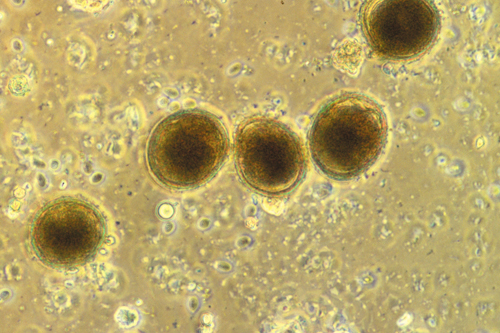Difference between revisions of "Feline Medicine Q&A 09"
Ggaitskell (talk | contribs) |
Ggaitskell (talk | contribs) |
||
| Line 10: | Line 10: | ||
|q1=Identify these ova found on faecal flotation from a cat. What are their characteristic features? | |q1=Identify these ova found on faecal flotation from a cat. What are their characteristic features? | ||
|a1= | |a1= | ||
| − | These are Toxocara cati ova. | + | These are ''Toxocara cati'' ova. |
Characteristic features include their size (approximately 70 μm), they are almost round, and they have a thick, pitted wall. Toxascaris leonina ova are a similar size but more oval, and have a smooth wall. | Characteristic features include their size (approximately 70 μm), they are almost round, and they have a thick, pitted wall. Toxascaris leonina ova are a similar size but more oval, and have a smooth wall. | ||
| Line 16: | Line 16: | ||
|q2=What is the life cycle of the organism involved? | |q2=What is the life cycle of the organism involved? | ||
|a2= | |a2= | ||
| − | Toxocara cati is a common nematode parasite. Adult worms (8–15 cm long) are found in the small intestine. | + | ''Toxocara cati'' is a common nematode parasite. Adult worms (8–15 cm long) are found in the small intestine. |
The life cycle is either direct or indirect. Developing larvae moult twice within the ova. Infective third stage larvae are released following ingestion of the ova, penetrate through the gastrointestinal tract and undergo a liver–lung migration path, returning to the gastrointestinal tract via the trachea (being coughed up and swallowed). Larvae then complete development into adults in the intestine. | The life cycle is either direct or indirect. Developing larvae moult twice within the ova. Infective third stage larvae are released following ingestion of the ova, penetrate through the gastrointestinal tract and undergo a liver–lung migration path, returning to the gastrointestinal tract via the trachea (being coughed up and swallowed). Larvae then complete development into adults in the intestine. | ||
| Line 28: | Line 28: | ||
Patent infections occur in kittens as young as 6 weeks of age, but clinical signs are uncommon. Heavy infections can cause unthriftiness, weight loss and vomiting/diarrhoea in kittens. | Patent infections occur in kittens as young as 6 weeks of age, but clinical signs are uncommon. Heavy infections can cause unthriftiness, weight loss and vomiting/diarrhoea in kittens. | ||
| − | Toxocara cati is a rare zoonosis (visceral/ocular larva migrans), most human disease being caused by T. canis. | + | ''Toxocara cati'' is a rare zoonosis (visceral/ocular larva migrans), most human disease being caused by ''T. canis''. |
|l3=Toxocara cati | |l3=Toxocara cati | ||
|q4=What treatment should be recommended? | |q4=What treatment should be recommended? | ||
Revision as of 11:51, 25 August 2011
| This question was provided by Manson Publishing as part of the OVAL Project. See more Feline Medicine questions |
| Question | Answer | Article | |
| Identify these ova found on faecal flotation from a cat. What are their characteristic features? | These are Toxocara cati ova. Characteristic features include their size (approximately 70 μm), they are almost round, and they have a thick, pitted wall. Toxascaris leonina ova are a similar size but more oval, and have a smooth wall. |
Link to Article | |
| What is the life cycle of the organism involved? | Toxocara cati is a common nematode parasite. Adult worms (8–15 cm long) are found in the small intestine. The life cycle is either direct or indirect. Developing larvae moult twice within the ova. Infective third stage larvae are released following ingestion of the ova, penetrate through the gastrointestinal tract and undergo a liver–lung migration path, returning to the gastrointestinal tract via the trachea (being coughed up and swallowed). Larvae then complete development into adults in the intestine. Larvae are also present in tissues of paratenic hosts (mice, chickens, earthworms, cockroaches) that have eaten ova. This is a common source of infection for cats (via ingestion), following which the larvae usually develop to adults within the gastrointestinal tract without further migration. A third route of infection is via the milk in suckling kittens. Larvae released from ingested ova migrate to many tissues where they remain dormant, but can subsequently be recovered from the mammary tissue and milk of suckling queens. There is no transplacental migration. |
Link to Article | |
| What is the potential clinical significance of the organism? | Patent infections occur in kittens as young as 6 weeks of age, but clinical signs are uncommon. Heavy infections can cause unthriftiness, weight loss and vomiting/diarrhoea in kittens. Toxocara cati is a rare zoonosis (visceral/ocular larva migrans), most human disease being caused by T. canis. |
Link to Article | |
| What treatment should be recommended? | Treatments include fenbendazole, milbemycin, pyrantel, febantel, and selamectin. |
Link to Article | |
